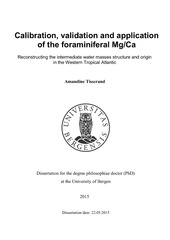Calibration, validation and application of the foraminiferal Mg/Ca. Reconstructing the intermediate water masses structure and origin in the Western Tropical Atlantic
Doctoral thesis
Permanent lenke
https://hdl.handle.net/1956/10043Utgivelsesdato
2015-05-22Metadata
Vis full innførselSamlinger
- Department of Earth Science [1050]
Sammendrag
The Atlantic Meridional Overturning Circulation (AMOC) plays a central role in the northward distribution of heat. It is a key mechanism in the climatic system that needs to be further understood. Most studies focused on surface or deep water conditions. Relatively little is known about the role of subsurface, thermocline and intermediate waters, where heat uptake and/or transport occur. Our aim is to give a better representation of the hydrography during the past by reconstructing the upper water column from surface to intermediate waters. Understanding of how changes in the upper water masses properties is crucial for determining the role of oceanic heat distribution involved in the AMOC and is the main objective of this PhD project. The Western Tropical Atlantic is a sensitive oceanic region connected with surface and intermediate waters that flow from the Southern Hemisphere into the North Atlantic and a deep water mass from the Northern Hemisphere. This region is unique in identifying the upper limb pathway of the AMOC and associated water masses. In this context, using sediment cores from depth transects is therefore crucial for estimating not only the magnitude of change but, particularly the orientation of water mass distribution change. Seven coring sites have been retrieved that fall along a depth transect extending from 600 to 1000 m water depth. Main strategy is to use different planktonic species having different depth habitat to reconstruct the upper surface to about 200-400 m water depth, and furthermore benthic species from depth of the coring sites to reconstruct water mass changes further below to 1000 m. The PhD project has two major objectives. The first is to calibrate and validate relationship between Mg/Ca ratio and temperature in benthic foraminiferal shells. Mg/Ca ratio in several benthic foraminifer species from core-tops were analysed to develop Mg/Ca calibrations over the 0-6 degrees Celsius temperature range in the Atlantic Ocean (Paper I). Apart from temperature, other factors may exert additional influences on foraminiferal Mg/Ca. For that purpose, the effect of the seawater carbonate chemistry on the magnesium incorporation into the foraminiferal calcite have been investigated for the benthic foraminifer species Cibicidoides wuellerstorfi (Paper II). In the second part of this project, we have applied the improved C. wuellerstorfi Mg/Ca-temperature calibration to examined surface, subsurface, thermocline and intermediate water conditions during the last deglaciation. Combining with water densities estimates and ventilation ages, we are trying to bring important insights on discerning sources of subsurface and intermediate waters (Paper III). This PhD work introduces a relatively new concept of investigating the hydrology along a core section in the upper water column. Looking to the future, we recommend a parallel strategy of applying proxies with refinements in methods and understanding of mechanisms that control the proxy.
Består av
Paper I: Tisserand, A. A., Dokken, T. M., Waelbroeck, C., Gherardi, J. M., Scao, V., Fontanier, C., & Jorissen, F. (2013). Refining benthic foraminiferal Mg/Ca‐temperature calibrations using core‐tops from the western tropical Atlantic: Implication for paleotemperature estimation. Geochemistry, Geophysics, Geosystems, 14(4), 929-946. The article is available at: http://hdl.handle.net/1956/10042.Paper II: Tisserand, A. A., Dokken, T. M., Gherardi, J. M., Waelbroeck, C. & Peeters, F. J. C. Revisiting the carbonate ion saturation effect on Mg/Ca in the benthic C. wuellerstorfi in the Atlantic Ocean. Full text not available in BORA.
Paper III: Tisserand, A. A., Dokken, T. M., Oppedal, L. T., Waelbroeck, C. & Peeters, F. J. C. Deglacial evolution of surface to intermediate water mass characteristics in the western tropical Atlantic. Full text not available in BORA.
